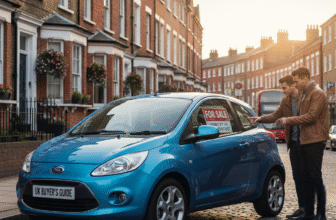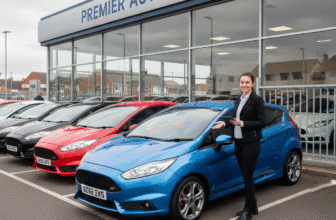
Your Ultimate Guide to Buying a Car for Sale in the UK: From Search to Signature
There’s a unique thrill that comes with the hunt for a new car. It’s a milestone, a symbol of freedom, and often, one of the biggest purchases you’ll make. Whether you’re a first-time buyer with freshly printed L-plates or a seasoned motorist looking for an upgrade, navigating the bustling UK used car market can feel like both an exciting adventure and a daunting challenge. The sheer volume of adverts for a ‘car for sale’ can be overwhelming. But fear not. With the right knowledge, a bit of patience, and a methodical approach, you can drive away with a reliable vehicle and a fantastic deal, avoiding the common pitfalls along the way. This comprehensive guide is designed to be your trusted co-pilot, steering you through every stage of the process, from initial budget planning to the final, satisfying turn of the key in your new ignition.
Phase 1: The Crucial Homework Before You Search
Jumping straight onto online marketplaces is tempting, but the savvy buyer starts with a pen and paper (or a spreadsheet). Laying the groundwork properly will save you time, money, and a world of potential headaches down the line.
Setting Your Budget: More Than Just the Sticker Price

The price you see in the advert is just the beginning. The total cost of ownership is a far more important figure. Your budget needs to account for:
- Insurance: This can be a huge variable, especially for new or young drivers. Get some online quotes for cars you’re considering *before* you go to a viewing. A sporty, high-performance car might seem like a bargain until you see the four-figure insurance premium.
- Vehicle Excise Duty (VED or Car Tax): This is based on CO2 emissions and the car’s list price when new. You can check the exact rate for any vehicle on the GOV.UK website using the registration number. Some cars, particularly older, low-emission models or electric vehicles, may even be free to tax.
- Running Costs: Think about fuel economy (miles per gallon or MPG). A large, petrol-guzzling SUV will cost significantly more to run on a weekly basis than a small, efficient city car. Also, factor in an annual service and MOT, which can easily add a few hundred pounds to your yearly spend.
- Contingency Fund: It’s a golden rule of used car buying: always keep a portion of your budget aside for unexpected repairs. Even a well-maintained car can develop a fault. Having £500 to £1,000 in reserve provides a vital safety net.
Choosing the Right Car for Your UK Lifestyle
Think honestly about your daily needs. Do you mostly do short city trips? A small hatchback or an electric vehicle (EV) could be perfect. Do you have a growing family and need space for car seats and luggage? An estate or an MPV would be a better fit. Are you a sales rep who spends hours on the motorway? A comfortable diesel saloon might be the most economical choice for long-distance cruising.
Mind the Zones: ULEZ, CAZ, and LEZ
This is a critical consideration for modern UK motoring. London’s Ultra Low Emission Zone (ULEZ) and the growing number of Clean Air Zones (CAZ) and Low Emission Zones (LEZ) in cities like Birmingham, Bristol, and Glasgow impose daily charges on older, more polluting vehicles. Generally, this affects pre-2006 petrol cars and pre-2015 diesel cars. Driving a non-compliant car into one of these zones can result in a hefty daily charge. Always use the official online checkers to verify a car’s compliance if you live in or regularly travel to these areas. It could save you thousands per year.
Phase 2: The Hunt Begins: Where to Find Your Next Car
Once you know what you’re looking for and what you can afford, it’s time to start the search. The main options are dealerships and private sellers, each with distinct advantages and disadvantages.
Dealerships vs. Private Sellers
Dealerships:
Buying from a reputable dealer offers the greatest peace of mind. Under the Consumer Rights Act 2015, a used car from a dealer must be of satisfactory quality, fit for purpose, and as described. This gives you significant legal protection if a serious fault emerges shortly after purchase. Many dealers also offer warranties, conduct multi-point checks, and will have serviced the vehicle. The downside? You will almost always pay a higher price than you would for an equivalent private sale.
Private Sellers:
This is where you’ll often find the best bargains. You’re buying directly from the owner, who can give you a personal history of the car. However, the principle of ‘caveat emptor’ (buyer beware) applies. Your legal rights are far more limited. The car only needs to be “as described” and the seller must have the legal right to sell it. There’s no comeback if it develops a fault a week later. This route requires more diligence from you as the buyer.
Decoding Online Adverts and Spotting Red Flags
When scrolling through listings, learn to read between the lines. A good advert will have plenty of clear, well-lit photos from all angles, including the interior and engine bay. The description should be detailed and honest, mentioning service history, recent work, and any known faults.
Red flags include:
- Very few, poor-quality, or obscured photos.
- Vague descriptions like “drives well” or “first to see will buy.”
- The seller is unwilling to provide the registration number for you to do your own checks.
- Phrases like “sold as seen” or “no warranty” in a dealer ad – this is an attempt to sidestep their legal obligations.
Phase 3: The Critical Inspection: Your Guide to Due Diligence
You’ve found a promising candidate and arranged a viewing. This is the most crucial phase. Your inspection will determine whether you proceed, walk away, or negotiate the price.
Your Pre-Viewing Homework
Before you even leave the house, do these two essential checks online using the car’s registration number:
- MOT History Check (GOV.UK): This free government service is invaluable. It shows you if a car passed or failed its previous MOTs, the mileage recorded at each test, and any ‘advisories’ – issues that weren’t serious enough to cause a fail but may need attention soon. A long list of advisories for corrosion, oil leaks, or suspension wear should be a major warning sign. It also helps verify the mileage is genuine.
- Vehicle History Check: Often called an HPI check (after one of the main providers), this paid-for service is non-negotiable. It will tell you if the car has outstanding finance (if it does, the finance company could repossess it!), if it’s been reported stolen, or if it has been written off by an insurer. Never buy a car without one of these checks.
The On-the-Day Vehicle Walkaround
Arrange to see the car at the seller’s home address (the one on the V5C logbook). Meet in a public car park is a huge red flag. Go in daylight and, if possible, on a dry day. Take your time and be methodical.
- Bodywork: Look down the sides of the car for ripples that could indicate crash repairs. Check for mismatched paint colours between panels. Look for rust, especially on the wheel arches, sills (below the doors), and boot floor.
- Glass and Lights: Check all glass for chips and cracks. A chip in the driver’s line of sight could be an MOT fail. Ensure all lights and indicators work correctly.
- Tyres: Check the tread depth – it needs to be at least 1.6mm across the central three-quarters of the tyre. Look for uneven wear, which could suggest steering or suspension issues. Ensure all four tyres are from a reputable brand; a mix of budget tyres can suggest corners have been cut on maintenance.
- Under the Bonnet: Ask for the engine to be cold when you arrive. A warm engine can hide starting problems. Check the oil level and colour (it should be golden or dark brown, not black and sludgy, or milky, which indicates head gasket failure). Check the coolant level. Look for any obvious leaks.
- The Interior: Does the wear and tear match the mileage? A worn-out driver’s seat and pedals on a car with supposedly low mileage is suspicious. Test every single button, switch, and gadget. Air conditioning, electric windows, stereo, sat-nav – check them all.
Phase 4: The All-Important Test Drive
The test drive is where you get a real feel for the car’s mechanical health. Insist on a drive of at least 20-30 minutes on a variety of roads – slow town traffic, a bumpy B-road, and a faster dual carriageway or motorway if possible.
- Starting Up: Listen for any rattles or excessive smoke from the exhaust when the car starts from cold.
- Brakes, Clutch, and Gears: Do the brakes feel sharp and pull the car up in a straight line? If it’s a manual, does the clutch bite at a reasonable point, or is the pedal very high? Are the gear changes smooth?
- Steering and Suspension: Does the steering feel direct, or is there too much play? On a straight road, does the car pull to one side? Drive over a few bumps and listen for any clunks or bangs from the suspension.
- Listen Carefully: Turn the radio off. Listen for any whining from the engine, rumbling from the wheels (which could be a wheel bearing), or knocking sounds as you drive.
Phase 5: Sealing the Deal: Negotiation and Paperwork
If the car has passed your inspection and test drive, it’s time to talk money. If you found any issues – tyres that will need replacing soon, for example – you can use this as polite leverage to negotiate the price down. Be realistic and fair.
The Paperwork Trail: Getting it Right
This is not the time to rush. Carefully check all the documents.
- The V5C Logbook: This is the most important document. Check that the name and address of the seller match their ID and the location you’re at. The Vehicle Identification Number (VIN) on the V5C should match the VIN on the car itself (usually found at the base of the windscreen and on a plaque inside the driver’s door).
- Service History: A stamped service book or a collection of receipts from garages is a great sign that the car has been cared for. Check that the work has been done at regular intervals.
- Payment and Receipt: A bank transfer is the most secure method for both parties. It creates an electronic record of the transaction. Avoid carrying large amounts of cash. Always write up a simple receipt for both of you to sign. It should include the car’s details (make, model, registration, VIN), the date, the price paid, and the names and addresses of both the buyer and seller.
Phase 6: You’ve Bought the Car! The Final Steps
Congratulations! But you’re not quite done yet.
- Tax it: You cannot drive a car away without it being taxed in your name. You can do this instantly online using the 12-digit reference number from the green ‘new keeper’ slip (V5C/2) that the seller gives you.
- Insure it: It is illegal to drive on a public road without insurance. Have your chosen insurance policy ready to activate the moment you agree to buy the car. Most insurers let you set this up in advance.
- Inform the DVLA: The seller is responsible for telling the DVLA they have sold the car. The quickest way is for you both to do it together online via the GOV.UK website. If not, ensure they tear off the green new keeper slip for you and send the rest of the V5C off to the DVLA. You should receive your new V5C in your name within a few weeks.
Your New Journey Awaits
Buying a used car is a significant undertaking, but it doesn’t have to be a game of chance. By being prepared, methodical, and patient, you empower yourself to make a smart and informed decision. You transform from a hopeful punter into a savvy consumer. Take your time, trust your instincts, and follow these steps, and you’ll be well on your way to enjoying miles of happy, trouble-free motoring in your perfect new-to-you car.







